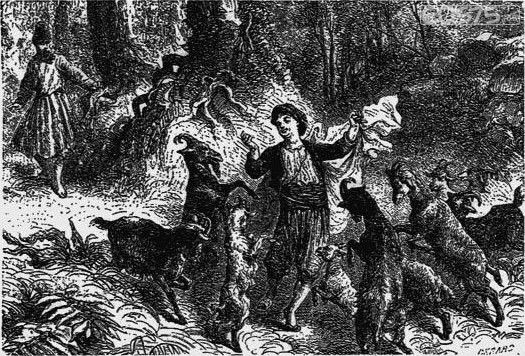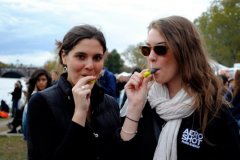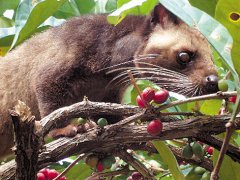The legend of coffee there are many legends about the discovery of coffee.
There are many legends about the discovery of coffee, one of which is according to Rothschild, a Roman linguist. The record of Neroy (1613-1707): around the sixth century, when Kardai, an Arab shepherd, was herding sheep to the Isobian prairie for grazing, he was very excited and excited to see each goat. Later, after careful observation, he found that these sheep were excited only after eating some kind of red fruit. Carl tasted some of them curiously and found that these fruits were often sweet and delicious. After eating, he also felt very refreshed, and from then on he often drove the sheep to eat this delicious fruit. Later, a Muslim passed by and picked some of the incredible red fruit to go home and share it with his parishioners, so its magical effect spread.

Other legends are Shrek, the patron saint of the Arabian Peninsula. Xue Ke, a disciple of Caldy. Omar was a respected and beloved chief in Mocha, but she was expelled by her tribe for committing a crime. Shack. As a result, Omar was exiled to Osama in the country, where she stumbled upon the fruit of caffeine in 1258. One day, Omar was walking hungry in the mountains and saw birds with strange feathers on the branches pecking at the fruit of the trees. He took the fruit back and boiled it with water, only to emit a rich and attractive fragrance, and the original feeling of exhaustion was eliminated after drinking it, full of vitality. Omar collected many of these magical fruits, and when she met someone who was sick, she made the fruit into soup for them to drink and refreshed her spirit. Because he did good everywhere and was loved by believers, his sins were soon forgiven, and when he returned to Mocha, he was praised for his fruit, and people did not worship him as a saint. At that time, the magic cure was said to be coffee.
Apart from the two legends that people like to talk about, it is impossible to tell when coffee will become a drink in people's lives. But according to ancient Arabic texts, in the 11th century, Muslim precepts forbade believers to drink, and it was popular in the Arab region to boil sun-dried coffee beans into soup and use them as stomach medicine. The believers found that the coffee juice had a refreshing effect, so they used it as an inspiring drink instead of alcohol, and spread the drink through believers to Egypt, Iran, Turkey and other places, centering on Mecca, the Muslim holy land. After the 13th century, Arabs knew how to dry raw coffee beans, bake them, mash them with a mortar and pestle, and then boil them with water to get purer coffee.
As for shops that sell coffee, it is said that it began in Mecca, a Muslim shrine. Around the 17th century, coffee gradually became popular in Italy, India, Britain and other places through trade routes. Around 1650, Oxford, England appeared the first coffee shop in Western Europe filled with the smell of coffee all day long.
The beauty of the beverage coffee
At present, there are about 70 countries in the world that cultivate coffee. If you spread out the world map, you can find that south of the Tropic of Cancer and north of the Tropic of Cancer, this area is the most suitable for growing coffee, called the "coffee" belt. The highland at an altitude of 1000 to 1500 meters is the most suitable place to grow coffee, and the coffee beans harvested are of the best quality. Coffee is a tropical plant and belongs to the evergreen shrub of Akanaceae. The height of the wild is as high as 4-7 meters, while the pruning of artificial growers is about 2 meters. It takes about 4-5 years from sowing, transplanting seedlings to growing into mature trees in the coffee garden, and its economic life is about 30 years. It takes 12 months from flowering, fruiting to harvest, so a coffee tree can be harvested about 25 times in a lifetime. The fruit of coffee is dark green at birth, goes through yellow and red, and finally becomes a crimson mature fruit. The normal fruit contains a pair of seeds, which are "coffee beans". After baking and cooking, and then adding all kinds of seasonings, it has become a colorful coffee world popular all over the world.
Important Notice :
前街咖啡 FrontStreet Coffee has moved to new addredd:
FrontStreet Coffee Address: 315,Donghua East Road,GuangZhou
Tel:020 38364473
- Prev

Coffee creative products subvert the division of coffee
I believe everyone already knows a lot about coffee, but recently it has been found that it also belongs to the molecular cooking of coffee. The public usually do things to make coffee, make coffee and drink coffee, but now this new thing does not need to add the above process to enjoy coffee, it is very simple, just one word. Yeah, it's coffee. It looks like a lipstick.
- Next

Palm Cats and Coffee beans basic knowledge of Fine Coffee beans
There are dense coffee trees on the Indonesian island of Sumatra. For hundreds of years, the residents of the island have made a living by collecting coffee beans. But in recent years, whenever the coffee is about to ripen, the troubles of the islanders also come. This is because a kind of animal called palm cat began to live and breed on the island. Palm cats like to eat coffee fruits, often before people start.
Related
- Detailed explanation of Jadeite planting Land in Panamanian Jadeite Manor introduction to the grading system of Jadeite competitive bidding, Red bid, Green bid and Rose Summer
- Story of Coffee planting in Brenka region of Costa Rica Stonehenge Manor anaerobic heavy honey treatment of flavor mouth
- What's on the barrel of Blue Mountain Coffee beans?
- Can American coffee also pull flowers? How to use hot American style to pull out a good-looking pattern?
- Can you make a cold extract with coffee beans? What is the right proportion for cold-extracted coffee formula?
- Indonesian PWN Gold Mandrine Coffee Origin Features Flavor How to Chong? Mandolin coffee is American.
- A brief introduction to the flavor characteristics of Brazilian yellow bourbon coffee beans
- What is the effect of different water quality on the flavor of cold-extracted coffee? What kind of water is best for brewing coffee?
- Why do you think of Rose Summer whenever you mention Panamanian coffee?
- Introduction to the characteristics of authentic blue mountain coffee bean producing areas? What is the CIB Coffee Authority in Jamaica?

